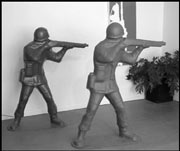IT’S JUST LIKE THE MOVIES, THE SEQUEL
Li’l Red Shack, 1028 First, 621-7807 noon-5 p.m. Thurs.-Sun. ends Sun., Aug. 11
Next month’s one-year anniversary of Sept. 11 is sure to bring with it countless television specials and millions of square yards of red, white, and blue. But this weekend is your last chance to see a commemoration of a different kind, an art exhibit that addresses the private toll of the terrorist attacks and takes a quiet, penetrating look at our changed psyches.
The Li’l Red Shack, lodged in a ramshackle building that cowers in the shadow of Safeco Field, has made something of a specialty of responding to current events. “Deconstruction/Construction,” for example, invited reflection on Seattle’s 2001 earthquake. (It culminated in the building of a scale model of one square block of Pioneer Square, constructed out of thousands of small white bricks.) Earlier this year, there was “It’s Just Like the Movies,” which addressed the country’s shattered sense of personal safety after Sept. 11. And now there’s “It’s Just Like the Movies, the Sequel” on the same topic.
Why? “Time separates us,” says Keith Tabellione, director of this artist-run, nonprofit gallery. “It’s important to react right away, but equally so when we have put space between ourselves and the event. It’s easy to push aside or forget our feelings, especially since the media always has some new horrible thing to distract us with.”
Tabellione sees a therapeutic function for the show. “I wanted to provide a space where people could feel safe and express themselves. If as a society we could really do that, we could find a way to live in harmony.” This sounds like a formula for art that is stunningly trite and/or tediously political, but “It’s Just Like the Movies, the Sequel” is, at its best, imaginative, engaging, and artfully oblique.
This is especially true of Tabellione’s own work. In FLAG, the top third of an enormous American flag has been cut into segments, each segment suspended in a jar of water, and the jars arranged to form the original shape and appearance of the stars and stripes. The magnifying power of the water causes the flag segments to appear connected through the barrier of the jar walls. It’s a radical transformation that can be taken as either desecration or reverence: The flag has been mutilated; it has also been preserved.
The most dramatic piece in the show is Army Men by James Reid, a series of life-sized resin sculptures in the shape of plastic army men. They are deployed throughout the gallery, variously suspended from the ceiling, sliced in half, and pointing their guns into space. The piece does invite a pat interpretation: Seemingly innocent childhood games are based on violence, nationalism, and machismo. But the sculptures—with their warm textures and whimsical lumpiness—are such fascinating and attractive objects that Army Men becomes more than a political statement.
Perry Johnson and Gary Berg have taken up the theme of personal safety most directly. Johnson’s wood, foam, and steel assemblage “Walking House” consists of a miniature wooden house that has sprouted spiderlike limbs of rebar, and appears to be scuttling across the gallery floor. It captures the feeling of surreal horror produced by the Sept. 11 attacks, and powerfully dramatizes our new awareness that the structures meant to shelter us are potential instruments of death. Gary Berg’s three untitled sculptures consist of pieces of cast concrete, each bearing a single cryptic word: “skin,” “howl,” and “fall.” Shaped to suggest either tombstones or pieces of a building, the sculptures offer another disturbing look at the intersection of death and shelter.
The best of the art in “It’s Just Like the Movies, the Sequel,” succeeds because it yields multiple meanings without dictating what our reactions should be. The few overtly political pieces in the show strike a jarring note in what is otherwise a meditative exploration of safety and fear. Despite the subject matter, the overall effect is calming, much like the way Tabellione’s water-filled jars capture the light.
info@seattleweekly.com 








